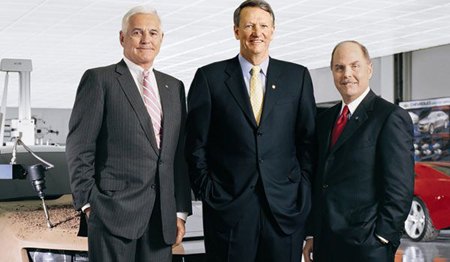Editorial: General Motors Death Watch 239: Rick Wagoner's Resignation
General Motors CEO Rick Wagoner is set to resign his position tomorrow. The timing of Wagoner’s departure is clearly symbolic. It’s meant to signal the nation that it’s OK throw bailout billions GM’s way because it’s a new day. Well, there’s a new guy at the top, anyway. Which may or may not be true, depending on whether or not Wagoner’s hand-picked successor and virtual clone Fritz Henderson inherits the job. If Henderson gets the nod, the symbolism of Wagoner’s defenestration will be far richer than its architects intended. For it will confirm the growing suspicion that the president’s mantra of hope and change is heavy on the hope and light on the change. And while that plays out, Wagoner’s resignation will eventually be seen as a way point on a journey of self-destruction, rather than a turning point on a bridge to . . . nowhere.
This is not the place for a post mortem examination of Rick Wagoner’s career as a GM lifer. There is no need nor room for debate about Wagoner’s negative impact on the artist formerly known as the world’s largest automaker. By any objective metric—market share, profitability, share price, capitalization, anything—Wagoner’s tenure at the top was an abject, epic failure. In fact, I pronounced Wagoner R.I.P. three years ago, in March 2006. I said it then, I’ll say it now: it’s too late to save General Motors. General George S. Patton himself could rise up from the dead, slap a few of Wagoner’s soldiers, assume command and fail. All Wagoner’s replacement can do, indeed should do, is prepare the automaker for bankruptcy.
Wagoner leaves GM buried [barely] alive under a Himalayan mountain of debt, much of it his creation (under the guise of lowering operating costs). The company which once held the title as the world’s most profitable corporation now carries some $46.5B worth of debt. President Obama could add 20 or 30 or even 50 billion dollars in “loans” for GM tomorrow. He could force a 100 percent debt-for-equity swap for ten cents on the dollar amongst GM’s bondholders. He could dictate that the United Auto Workers accept stock in lieu of ANY contribution to its Mother of All Health Care Funds. And it still wouldn’t be enough to extricate General Motors from its current predicament.
GM has been and will continue to be an over-dealered, under-funded mess. Its brands are a complete disaster. Even the brands with some remaining psychological equity—Chevrolet and Cadillac chief amongst them—are suffering from bailout backlash as Americans grow angry at the increasingly obvious black hole that is Bailout Nation. With a handful of notable exceptions (mainly because they ARE exceptions), GM’s products are not competitive. And, lest we forget, the U.S. new car market is still contracting violently, with millions of unsold units just waiting for their makers to give up, sell them at any price and further depress sales and profits. In short, GM currently has zero opportunity for relative or absolute growth.
Given this hopeless morass, Wagoner’s resignation comes at the worst possible moment. It will fuel the boundless, baseless optimism which led to the first $17.4B GM bailout (not including a share of the Department of Energy’s $25B retooling loans or the $1B GMAC-related loan). Of course, that’s the entire point: Wagoner’s sword-falling routine gives the Obama administration and his Presidential Task Force on Automobiles something “concrete” upon which to pin their empty message of future auto industry transformation. What’s more, with Wagoner out of the way, the president can amp-up his electric car and high mileage dreams. See? We’re not subsidizing the same old SUV-building bastards. We’re reinventing the car industry!
What’s the bet Wagoner will announce his resignation without a single mea culpa? His statement will be as short as it will be meaningless. Seed-sowing, torch passing, foundation building—no matter what the metaphor, the underlying message will be “I prepared GM for the success to follow.” The fact that there will be no success to follow is neither here nor there. The feds’ willingness to keep GM on taxpayer funded life support means that Wagoner will be enjoying the fruits of his labors—including his bankruptcy-proof pension—even as those who inherit his legacy of his incompetence struggle to extricate anything of value from the inevitable corporate carnage.
I can’t decide whether Wagoner’s career at GM is Wagnerian, Chekovian (Cherry Orchard), Millerian (Death of a Salesman) or Shakespearean (King Lear). In the final analysis, it’s all of the above. And as long as we’re going down the literary path, Wagoner is the ultimate Hollow Man. Although news of his resignation arrives with something of a bang, the company Wagoner guided will not end with equal force. Thanks to the men at the top of the GM pyramid it will end with a whimper.
More by Robert Farago
Latest Car Reviews
Read moreLatest Product Reviews
Read moreRecent Comments
- MaintenanceCosts I wish more vehicles in our market would be at or under 70" wide. Narrowness makes everything easier in the city.
- El scotto They should be supping with a very, very long spoon.
- El scotto [list=1][*]Please make an EV that's not butt-ugly. Not Jaguar gorgeous but Buick handsome will do.[/*][*] For all the golf cart dudes: A Tesla S in Plaid mode will be the fastest ride you'll ever take.[/*][*]We have actual EV owners posting on here. Just calmly stated facts and real world experience. This always seems to bring out those who would argue math.[/*][/list=1]For some people an EV will never do, too far out in the country, taking trips where an EV will need recharged, etc. If you own a home and can charge overnight an EV makes perfect sense. You're refueling while you're sleeping.My condo association is allowing owners to install chargers. You have to pay all of the owners of the parking spaces the new electric service will cross. Suggested fee is 100$ and the one getting a charger pays all the legal and filing fees. I held out for a bottle of 30 year old single malt.Perhaps high end apartments will feature reserved parking spaces with chargers in the future. Until then non home owners are relying on public charge and one of my neighbors is in IT and he charges at work. It's call a perk.I don't see company owned delivery vehicles that are EV's. The USPS and the smiley boxes should be the 1st to do this. Nor are any of our mega car dealerships doing this and but of course advertising this fact.I think a great many of the EV haters haven't came to the self-actualization that no one really cares what you drive. I can respect and appreciate what you drive but if I was pushed to answer, no I really don't care what you drive. Before everyone goes into umbrage over my last sentence, I still like cars. Especially yours.I have heated tiles in my bathroom and my kitchen. The two places you're most likely to be barefoot. An EV may fall into to the one less thing to mess with for many people.Macallan for those who were wondering.
- EBFlex The way things look in the next 5-10 years no. There are no breakthroughs in battery technology coming, the charging infrastructure is essentially nonexistent, and the price of entry is still way too high.As soon as an EV can meet the bar set by ICE in range, refueling times, and price it will take off.
- Jalop1991 Way to bury the lead. "Toyota to offer two EVs in the states"!


































Comments
Join the conversation
http://www.batteryuniversity.com/parttwo-34.htm The battery pack itself, rated at 16 kilowatts/hour, comprises more than 220 separate cells wired in series. That means the failure of any one cell disables the entire array, though some existing hybrid vehicles also have this flaw. The Volt pack is about six feet long and weighs a hefty 375 pounds. Voltage: 320 – 350 V 100% recharge time: 110V outlet: 6 – 6.5 h Electromotor: 45kW GM also claims the 2011 Chevrolet Volt can run solely on electric power for 40 miles with a full battery charge. That’s in line with studies showing that most Americans drive only about 40 miles a day, so in theory at least, a Volt could go for weeks without using a drop of gas or spewing any CO2. But some analysts think the real-world electric range will be closer to 30 miles and probably less, depending on vehicle speed, ambient temperature (which affects battery performance), and whether trips include steep grades. GM is confusing the battery pack characteristics because they are not sure: A Li Ion battery pack with a 72V, 450AH configuration, it charges in 2 hours, is 1/3rd the size of the lead acid batteries, weighs less, doubles the range, and they are simply fantastic.” Only problem? The cost for the pack is $10,000 for a car whose total cost is $12,800. Since the car-capable packs can cost between $10,000 and $15,000 each, finding a cheaper alternative will be a major hurdle for car companies that want to market them. The cost of maintenance for a hybrid car is also higher. Also it has more complex systems and engine, a normal mechanic may not know how to repair it. In most cases, you need to send back to the hybrid car manufacturer for maintenance and repair and the cost is not cheap. Hybrid cars use special tires that are wore out more easily than conventional cars. These hybrid car tires cost more and need to be replaced around 25,000 miles. Gasoline Engine: 3-cylinder, turbocharged; size 1L 160hp or 120kW Calendar Life Li-ion cells lose capacity with time, even if they are just sitting on a shelf. They lose the most early in their life (year one) and then continue to lose capacity gradually thereafter. http://www.batteryuniversity.com/parttwo-34.htm
I'm beginning to believe GM is too far reaching and forward thinking, crazy huh? Or is it, doesn't it seem they're always announcing some new idea, design or technology way too early? The Camaro, "Plug-In Hybrids" (aka the Volt), new battery technology, alliances, etc. All info have been released to the public via PR announcements, auto show concepts, etc. about 4-5 years prior to debut. This is a perfect example of why the new GM will fail yet again. They continually do things the same as always. Well how then should they handle future products? Coming from the semiconductor industry the answer for me is obvious. Look at a company like Intel or Apple, have they ever spilled the beans (officially) about any upcoming product release more than 30-90 DAYS in advance? GM talks then shows concepts and strategies years before production. Meanwhile, the Japanese, the Koreans and even the Chinese quietly develop competing products without fanfare or notice. And while GM continues to pontificate about how great their upcoming "whatever" will be (usually at some exorbitant price point), by the time it hits the market... too late. Everyone else has already perfected the idea and is not only delivering sooner, but with better quality, more content and most importantly... more cost-effectively!